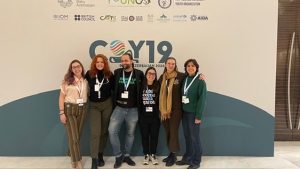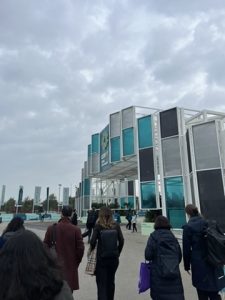Last year, I remember sitting on the floor waiting in Toronto for my flight with my friend Luna (who introduced me to this climate diplomacy world and was part of the Practicum cohort in 2023) reading and processing COP28 outcomes. I remember getting excited that “transitioning away from fossil fuels in energy systems, in a just, orderly and equitable manner” has been cited in the COP outcome document, the Global Stocktake (GST). I felt our actions the whole week were powerful and I even concluded that holding COPs in a petrostate is not a dead-end for a year of climate negotiations.
But then, COP29 happened, and it failed us as I haven’t experienced before (but I am sure this happened before in the COP’s history). The goal of COP29 was clear: to mobilize at least $1 trillion dollars from public or concessional money (grants) to support not only the energy transition (a fair and just transition) but also adaptation, and loss and damage for developing countries. But negotiations landed far from that. We left COP29 on Sunday with an agreement of 300 billion dollars coming from mixed sources without much transparency regarding developed countries’ responsibility in this scenario.
Many developing countries, especially LDCs (Least Developed Countries) and SIDs (Small Island Developing States), stated from the beginning that they couldn’t accept such a deal because the lack of compromise among developed countries was costing their communities. But they were pushed to accept such a number so the world would not see COP29 as a failure.
But it was.
The Paris Agreement is loud and clear: it is the developed countries responsibility to guarantee the world is fighting climate change because they are responsible for emissions. But they are not taking true accountability. How long will we be able to wait for the next COP to get a true resolution?
For the past year, all I have heard when I say I am from Brazil is people’s excitement about what will come out from COP30 at the heart of the Brazilian Amazon. But after such a difficult COP29, I wonder if Brazil will be able to reach everything people are expecting. Brazil has indeed already included the goal of raising trillions for climate finance next year, but will one single COP deliver what none of the 29 past ones did? Will the fossil fuel industry keep attending and shaping the climate change agenda as it did in the past years (with a delegation of around 1700 people in COP29)? Is the 1.5 degrees still within reach?
What I have realized inside the negotiation rooms following Loss and Damage negotiations is that there is a huge power imbalance between parties. LDCs and SIDs are raising their voices and needs, but even so, their demands are addressed only if they are in the interest of the most powerful parties.
For Loss and Damage, for example, there was a huge discussion on how the mechanisms to offer support to communities on the front lines are inaccessible for a lot of countries because of language and technical barriers. After a week of conversations about how to improve and review the mechanism, with the barriers to developing countries clear, we still didn’t have a drafted text and the presidency was pushing negotiations to end on Tuesday night of the second week.
What will it take for developing nations to be heard? What about their realities is not clear? We don’t have the luxury of time anymore.
I don’t have an answer to most of these questions and I think this is a reflex of how the process is: uncertain and sometimes unreliable. But as I have told before in my previous blog entries, we keep fighting because this is our only option. We keep fighting because we see the injustice and we value people.
I want to end my last reflection with my favorite chant of all from the climate movement (read this singing!):
“When the heat gets high (2x)
And the people rise (2x)
Can’t you hear us sing (2x)
It’s the end of fossil fuels (2x)”
Until COP30!


